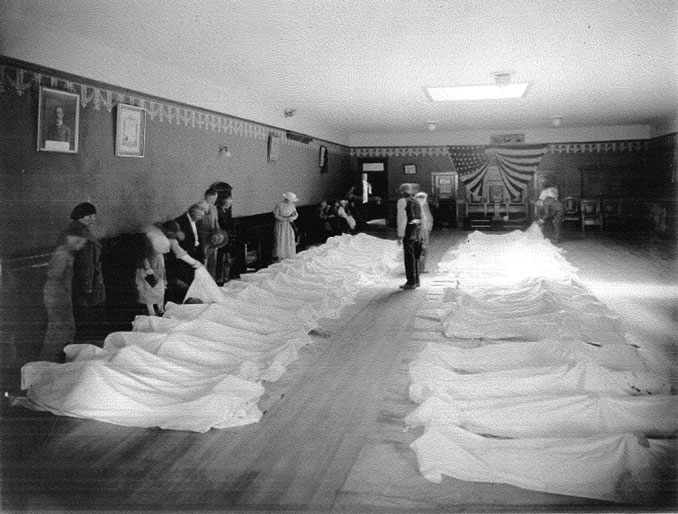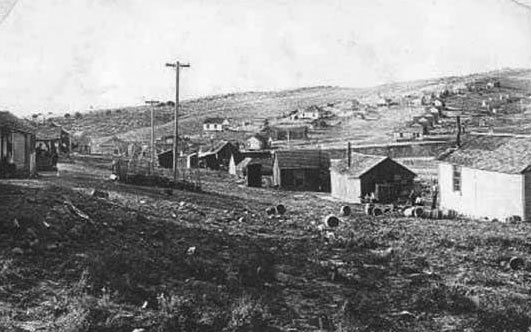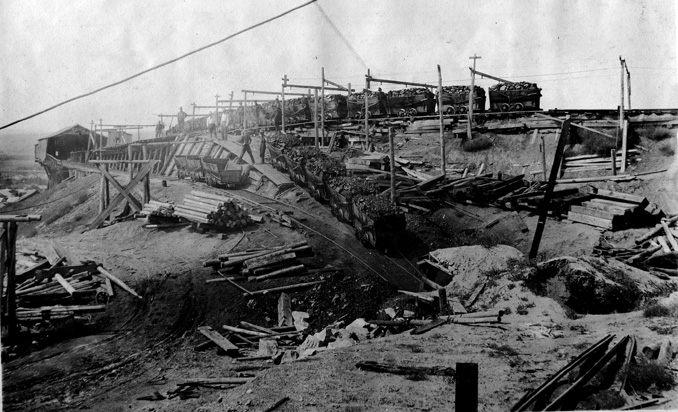- Home
- Encyclopedia
- The Most Dangerous Occupation: The Quest For Sa...
The Most Dangerous Occupation: The Quest for Safety in Wyoming’s Coal Mines
From the beginning of Wyoming Territory, coal miners worked in deep underground mines. Mining was the most dangerous occupation on the Western frontier—far more risky than rounding up cattle or working on the railroad—even more hazardous than driving Cheyenne and Black Hills stagecoaches or soldiering at old Fort Laramie.

The first coal mines in Wyoming, located along the Union Pacific Railroad line across the southern part of the territory, lacked many of the safety features required in today’s mines. Few mines had such rudimentary features as secondary air shafts for ventilation, auxiliary exits in case of cave-ins or dependable support beams. Before 1886, Wyoming mines were entirely unregulated. As a result, mine tragedies were frequent.
From the beginning of mining near Carbon in 1868 until 1925, 13 separate mine disasters resulted in the deaths of five or more miners. (According to the U.S. Bureau of Mines, the term “disaster” applies to any mine mishap in which five or more miners are killed.) Of course, this number does not count the individual incidents where individual miners often were killed, lost limbs or were otherwise maimed by cave-ins, explosions or equipment malfunctions within the mines.
The first mine disaster came in March 1881 near Almy, Wyo., north of Evanston. An explosion and fire killed 38 miners and destroyed several surface buildings. Five years later, at the same mine, 13 miners, including two young boys, died in another explosion.
The Wyoming Territorial Legislature was about to convene just days after the second mine disaster at Almy. In short order, legislators passed new mine safety laws. Similar bills had been introduced in earlier legislatures, but no action had been taken. The new law created the office of state mine inspector with the duty of inspecting every coal mine in Wyoming no less frequently than every three months. Further, the act banned boys under 14 from working underground. Women were also “protected” from the hazards of mining when it was made unlawful for them to work in mines.
Albany County legislator Stephen Downey tried to get his colleagues to give compensation to the families of Almy disaster victims, but lawmakers voted against the measure, reasoning that it would set a bad precedent.
In 1889, when Wyoming was drawing up a state constitution, delegates adopted much of the territorial law as Article 9 of the new constitution. Included was the provision: “The legislature shall provide by law for proper development, ventilation, drainage, and operation of all mines in this state.” The delegates endorsed both the earlier territorial law giving women the right to vote and the earlier ban on their working in mines. In fact, it wasn’t until 1979 that the Wyoming Constitution was changed, and women were allowed to work as miners.
Many miners believed exhaustion led to careless mishaps. In a separate section of the constitution, the drafters inserted the provision: “Eight hours actual work shall constitute a lawful days work in all mines. ...”
Even though these rudimentary measures were in place, newly formed labor unions, particularly in southwestern Wyoming, constantly sought improved working conditions and better safety for their members. Mining companies often complied. In mining towns early in the 20th century mine safety competed annually to see which team had the best response time or could better react to underground cave-ins. Winning teams were given trophies and pictured in the local newspaper.
Despite the new rules and better training, mine accidents remained commonplace—stories of individuals being crushed by falling rock or rescued from cave-ins appear in many turn-of-the-century Wyoming newspapers.
In March 1895, a mine at Red Canyon, near Evanston, exploded, killing 62 miners and causing the third greatest loss of life in any mine disaster in the state’s history. The explosion was heard clearly in downtown Evanston, seven miles from the mine site.
This tragedy, along with individual mishaps, brought increasing attention to safety in mines. Labor unions gained membership by promising to seek greater safety, and occasionally, these concerns were a primary reason for strikes. In their annual contract negotiations with coal companies, unions often pushed harder for safety reform than for increased compensation. Companies themselves, and entire communities, encouraged adherence to safety principles.
In the wake of the Red Canyon disaster, the Legislature continued to tighten safety requirements in Wyoming mines. The state mine inspector was authorized to hire deputies to assist him in investigating mine accidents and submitting reports. The law required inspections even in non-fatal accidents.
Despite the new rules, during the first decade of the 20th century, multiple major disasters befell miners at Diamondville, Wyo., near Kemmerer, and at Hanna. The two Diamondville mishaps occurred in the same mine in February and October 1901. Twenty-six miners suffocated in the first, when a cave-in trapped them deep in the mine. Barely eight months later, 22 more died in a similar cave-in. Four years later, 18 miners working on the night shift died when an explosion ripped through the same Diamondville mine. Reports said that the Dec. 2, 1905, explosion “destroyed cement and stone stoppings 18-24 inches thick.”
The greatest loss of life in any mine disaster in Wyoming occurred at Hanna on June 30, 1903, when 169 miners died after coal gas ignited in Mine No. 1. An additional 46 miners barely escaped from the mine. The accident decimated the town’s male population and left hundreds of orphaned children and widows. The mining company, a subsidiary of the Union Pacific Railroad, was condemned for refusing to compensate survivors beyond a meager amount for burial expenses. The explosion and ensuing publicity also brought national attention to dangers in Wyoming mines and increased state government concern for mine safety. Unions insisted on greater compensation for dependents of miners killed in such mishaps.

On March 28, 1908, the same Hanna mine that exploded in 1903 blew up again, trapping 18 miners deep underground. At 10:30 that evening, the state mine inspector and 40 other men entered the mine to rescue the trapped miners. Suddenly, a second explosion ripped through the shaft, shattering glass in houses in nearby Hanna and killing all of the would-be rescuers including the mine inspector. Bodies of only 32 of the 59 victims were recovered. The mine was sealed shut. In 1933, the town of Hanna erected a marker on the site memorializing those killed in both tragedies. The marker is located just south of the present Hanna-Elk Mountain High School.
As a result of the second Hanna disaster, the Legislature required inspectors to make more exhaustive examinations of mines, authorized them to stop work in “unlawful and dangerous mines” and at the same time substantially increased fines for mine owners who violated safety laws.
Still, accidents continued to plague Wyoming coal mines. At Cumberland, Wo.—now a ghost town between Evanston and Kemmerer—six men died in 1912 in a mine explosion caused by ignition of coal dust. Twenty other miners suffered serious injuries. Just two years later, in the same mine, a coupling failed while miners were returning to the surface from their shift underground. Seven cars plummeted to the bottom of the shaft. Many miners jumped to safety as the cars careened downward, but five could not escape and died in the incident.
Following those mishaps, the Legislature passed more mine safety rules. Mine accidents continued, however. In July 1920, a miner working at Sublet, Wyo. in Lincoln County, slammed a mallet against a keg of blasting powder. Six men died in the ensuing explosion. At another mine at Sublet in 1923, gas ignited by an arc from a locomotive trolley killed 39 miners. Succeeding legislatures continued to enact mine safety laws, at least one of which related to proper storage of blasting powder.
The second-worst coal mining tragedy in state history occurred in August 1923 near Kemmerer, Wyo. in Lincoln County. Only 135 of the usual 250 miners were working that day because it was a holiday. Ninety-nine of them died when the mine suddenly exploded. Investigators found that, prior to the blast, a fire boss apparently attempted to relight his flame safety lamp with a match. A group of 23 men barricaded themselves within the mine away from the flames until they were rescued hours after the initial explosion.
In February 1938, five miners died in a cave-in at a remote mine, at 8,200 feet in elevation, 75 miles from Afton in Lincoln County on Dead Man Creek. The mine foreman’s wife skied through four feet of snow to a ranch to get help. This was the last incident in a Wyoming mine in which as many as five people died.
In 1939, the mine inspector was authorized to inspect surface coal mines as well as the underground ones. Reflecting the increasing diversity of minerals mined in the state, the Legislature expanded the duties of the state mine inspector in 1957 to include more than coal mines, the inspector’s designated jurisdiction since 1886.
Finally, in 1990, more than a century after the mine inspector was established as a “constitutional office,” Wyoming voters repealed parts of Article 9. The office was shifted to the Wyoming Department of Employment. Despite the move, the state mine inspector still retains the authority to enter, inspect and examine any mining operation in the state, all in the name of safety and protecting workers in what has historically been Wyoming’s most dangerous occupation.

Resources
Primary Sources
- Wyoming Territorial Inspector of Mines. Reports, 1886-90. Cheyenne, Wyo.: Wyoming State Archives.
- Wyoming State Coal Mine Inspector. Annual Reports, 1891-1940. Cheyenne, Wyo.: Wyoming State Archives.
- Wyoming Session Laws, 1891-1939
Secondary Sources
- Gardner, A. Dudley and Verla R. Flores. Forgotten Frontier: A History of Wyoming Coal Mining. Boulder, Colo.: Westview, 1989.
- History of the Union Pacific Coal Mines, 1868-1940. Omaha: Colonial Press, 1940.
- Jones, Walter R. "Coal Mine Explosions at Almy: Their Influence on Wyoming's First Coal Mining Safety Law." Annals of Wyoming 56 (Spring 1984), 54-65.
- Kalisch, Philip A. “The Woebegone Miners of Wyoming: A History of Coal Mine Disasters in the Equality State.” Annals of Wyoming, 42 (Oct. 1970), 237-242.
- https://www.youtube.com/watch?v=206-qGmG0yA&list=PLLDkEadlZuPe2vvgmqVdY_...
Illustrations
- The photo of people identifying bodies in Kemmerer is from the Frank J. Meyers papers, American Heritage Center, University of Wyoming. Used with permission and thanks.
- The photo of George Kuzara’s Star King wagon mine is from the Kuzara Collection at the Wyoming Room, Sheridan County Fulmer Public Library. Used with thanks.
- The photo of Sublet, Wyo. in 1908 is from Wyoming Tales and Trails, via Wyoming Places. Used with thanks.
For further research
- Click here to watch a video of former Diamondville, Wyo., Mayor Susan Hunzie’s memories of her Yugoslavian grandfather, who came to Wyoming to work in the coal mines, helped rescue survivors after the 1923 Kemmerer mine blast and later died of black lung. Video produced by the University of Wyoming Haub School of Environment and Natural Resources and the Powder River Basin Resource Council.
